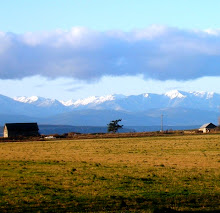 View of Camp Casey barracks.
View of Camp Casey barracks. The territorial government decided to focus their protection efforts around Port Townsend, Olympia, the San Juan Islands and near present day Bellingham, leaving Whidbey Island without soldiers assigned for protection. With the exception of Col. Isaac Ebey's murder in 1857, the islanders found that life with local native American neighbors was rather peaceful. In 1859 Pig War defined the final disputed boundary between the U.S. and Canada.
 Eagle on the Camp Casey parade field.
Eagle on the Camp Casey parade field.The growing population and the importance of the Puget Sound region for world-wide commerce brought Whidbey Island to the attention of the national government in the latter nineteenth century. The U.S. Government had been closely watching events in Spanish Colonies for a while. In the late 1800s the possibility of war with Spain finally convinced the government that protecting Puget Sound was a priority. The government sent the U.S. Army to the West Coast to find land suitable for coastal forts to protect major ports. Situated at the gateway to Puget Sound, home of the Bremerton Naval Shipyards and the ports of Tacoma & Seattle, Admiralty Head on Whidbey Island was an ideal place to construct a coastal fortification. The campaign to build a fort at Admiralty Head went on for more than 25 years. The fort construction was finally approved to begin in 1897 after purchasing donation land claim holdings from Dr. Kellogg. The new architecture of military fortifications on the West Coast featured the Endicott style, named after the Secretary of War at that time. Endicott style forts featured a basically symmetrical arrangement of guns starting with three inch guns on the end. Gun size grew progressively larger until the middle of the line of guns, then grew smaller again ending in three inch guns on the other end. The entire line of guns was hidden behind a cement parapet and was built in a way so it couldn't be seen from the water.
In conjunction with two other coastal forts across Admiralty Inlet, Fort Casey was one side of the formidable Triangle of Fire protecting Puget Sound from foreign navies. Construction began on Fort Casey shortly after the 1897 final approval. Fort Casey was still being built when the Spanish-American War broke out in 1898. The 10-week long war was fought in the Pacific and Caribbean, though not near the Washington coast.
Fort Casey created a new population cluster in Central Whidbey Island. The new base often hosted community events such as dances attended by Coupeville residents. The base played an active role in World War I, however the invention of airplanes and their role in modern warfare reduced Fort Casey’s usefulness as a source of protection for Puget Sound. The base was placed in caretaker status in 1926 until World War II.
The threat of aerial warfare in World War II forced the U.S. government to broaden their coastal defenses. No longer were large coastal artillery forts situated at the entrance to harbors effective protection. Better protection was offered by keeping hostile fleets and aircraft far from port entrances, preferably far out at sea. Fort Casey was reactivated during World War II, mostly as a training base. Anti-aircraft guns were places at Battery Kingsbury among other defenses. In 1942, to augment the Army defense of Puget Sound, the modern Fort Ebey was constructed along with the Oak Harbor’s Naval Seaplane Base to the north. Working together, these and other Washington bases successful deterred hostile forces from directly impacting Puget Sound.
After World War II Fort Casey and Fort Ebey were both placed in caretaker status and eventually sold. Washington State Parks and Seattle Pacific University purchased Fort Casey in 1956 and still own the properties today. Whidbey Island’s coastal forts no longer have protection as their main mission, now the mission is recreation.

Basketball game at Camp Casey.
Fort Casey State Park is home to the Admiralty Lighthouse, a beautiful waterfront campground, several hiking trails and the majority of the Fort Casey batteries. Camp Casey operates a conference center composed of most of the original Fort Casey barracks, mess halls, officers quarters and several other original buildings. This year, Camp Casey is hosting the Ebey’s Forever Conference, November 5 & 6. Come and explore Whidbey Island’s military history at Camp Casey and Fort Casey during this year’s conference. Register at http://www.ebeysforever.com/.
All photos provided by Seattle Pacific University's Camp Casey.



No comments:
Post a Comment